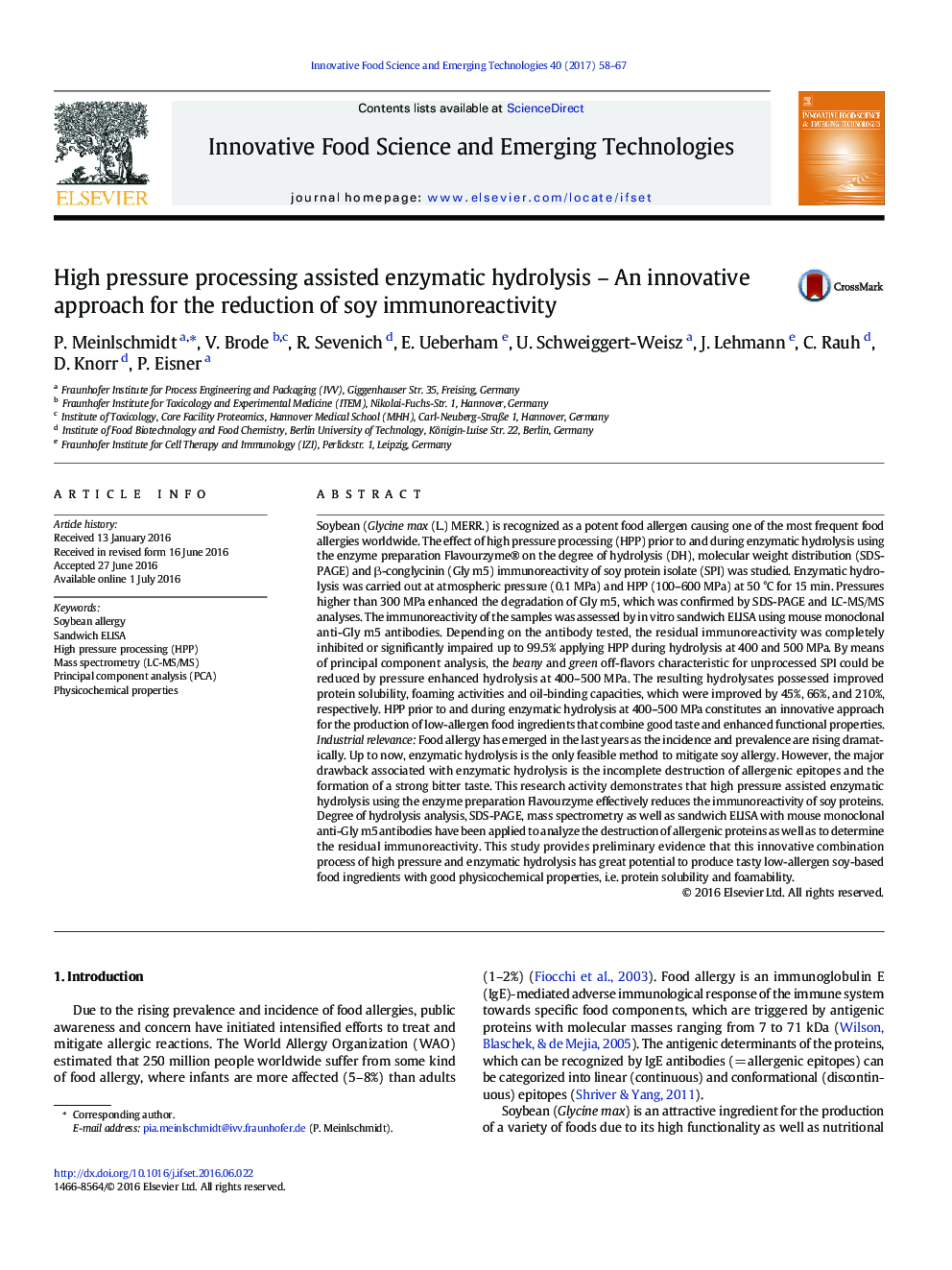| کد مقاله | کد نشریه | سال انتشار | مقاله انگلیسی | نسخه تمام متن |
|---|---|---|---|---|
| 5521798 | 1545528 | 2017 | 10 صفحه PDF | دانلود رایگان |
- High pressure assisted enzymatic hydrolysis at 400-500 MPa, 50 °C for 15 min nearly completely inhibited the immunoreactivity of soy protein isolates
- High pressure technology applied during enzymatic hydrolysis is significantly more successful that high pressure treatment prior to hydrolysis.
- Off-flavors of soy like beany, rancid and green were considerably reduced
- Foaming activity, protein solubility as well as oil-binding and emulsifying capacity were enhanced
Soybean (Glycine max (L.) MERR.) is recognized as a potent food allergen causing one of the most frequent food allergies worldwide. The effect of high pressure processing (HPP) prior to and during enzymatic hydrolysis using the enzyme preparation Flavourzyme® on the degree of hydrolysis (DH), molecular weight distribution (SDS-PAGE) and β-conglycinin (Gly m5) immunoreactivity of soy protein isolate (SPI) was studied. Enzymatic hydrolysis was carried out at atmospheric pressure (0.1 MPa) and HPP (100-600 MPa) at 50 °C for 15 min. Pressures higher than 300 MPa enhanced the degradation of Gly m5, which was confirmed by SDS-PAGE and LC-MS/MS analyses. The immunoreactivity of the samples was assessed by in vitro sandwich ELISA using mouse monoclonal anti-Gly m5 antibodies. Depending on the antibody tested, the residual immunoreactivity was completely inhibited or significantly impaired up to 99.5% applying HPP during hydrolysis at 400 and 500 MPa. By means of principal component analysis, the beany and green off-flavors characteristic for unprocessed SPI could be reduced by pressure enhanced hydrolysis at 400-500 MPa. The resulting hydrolysates possessed improved protein solubility, foaming activities and oil-binding capacities, which were improved by 45%, 66%, and 210%, respectively. HPP prior to and during enzymatic hydrolysis at 400-500 MPa constitutes an innovative approach for the production of low-allergen food ingredients that combine good taste and enhanced functional properties.Industrial relevanceFood allergy has emerged in the last years as the incidence and prevalence are rising dramatically. Up to now, enzymatic hydrolysis is the only feasible method to mitigate soy allergy. However, the major drawback associated with enzymatic hydrolysis is the incomplete destruction of allergenic epitopes and the formation of a strong bitter taste. This research activity demonstrates that high pressure assisted enzymatic hydrolysis using the enzyme preparation Flavourzyme effectively reduces the immunoreactivity of soy proteins. Degree of hydrolysis analysis, SDS-PAGE, mass spectrometry as well as sandwich ELISA with mouse monoclonal anti-Gly m5 antibodies have been applied to analyze the destruction of allergenic proteins as well as to determine the residual immunoreactivity. This study provides preliminary evidence that this innovative combination process of high pressure and enzymatic hydrolysis has great potential to produce tasty low-allergen soy-based food ingredients with good physicochemical properties, i.e. protein solubility and foamability.
Journal: Innovative Food Science & Emerging Technologies - Volume 40, April 2017, Pages 58-67
